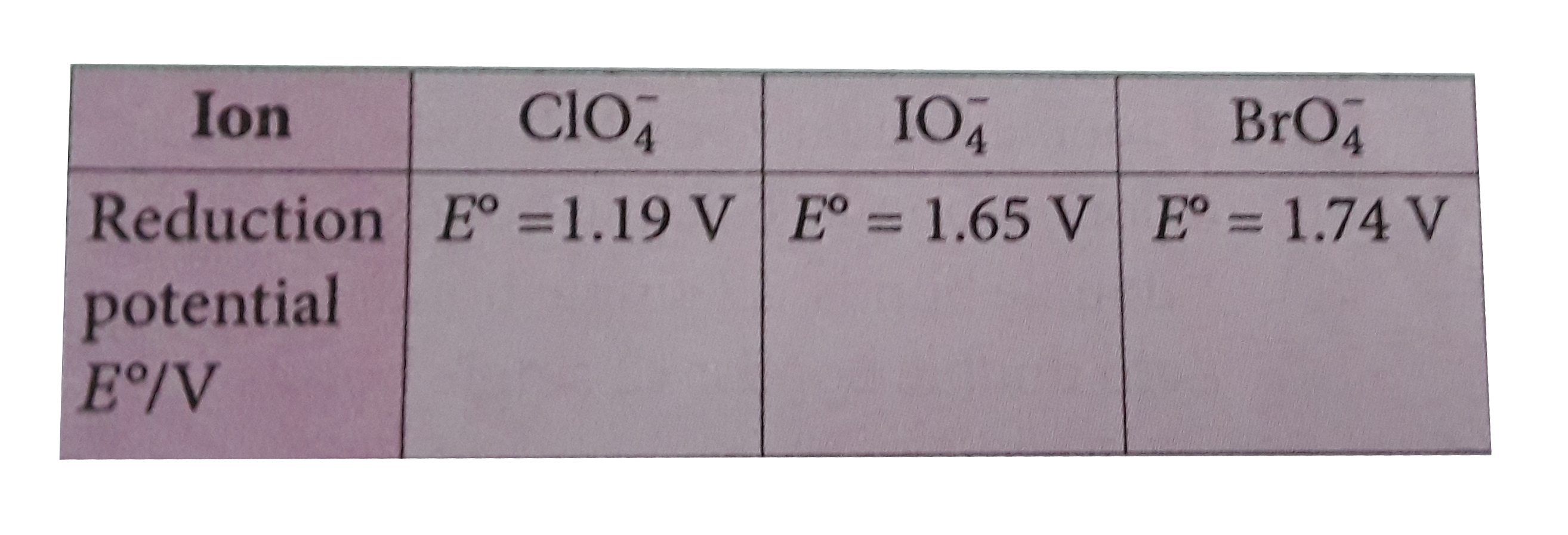বিজারণ বিভবের ভিত্তিতে ক্রমহ্রাসমান জারণ ক্ষমতা অনুসারে সাজাও- আয়ন (ClO_4^-,IO_4^-,BrO_4^-) ও বিজারণ বিভব E^0(V)(E0=1.19V,E0=1.65V,E0=1.74V)
ClO_4^rarrIO_4^rarrBrO_4^-
IO_4^rarrBrO_4^rarrClO_4^-
BrO_4^rarrIO_4^rarrClO_4^-
BrO_4^rarrClO_4^rarrIO_4^-
The correct Answer is:C
Topper's Solved these Questions
- P- ব্লক মৌল সমূহBOOK - CHAAYA PRAKASHINI (BENGALI)CHAPTER - P- ব্লক মৌল সমূহEXERCISE - EXERCISE
46 Videos
- P ব্লক মৌলসমূহBOOK - CHAAYA PRAKASHINI (BENGALI)CHAPTER - P ব্লক মৌলসমূহEXERCISE - EXERCISE
10 Videos
- p- ব্লক মৌলসমূহBOOK - CHAAYA PRAKASHINI (BENGALI)CHAPTER - p- ব্লক মৌলসমূহEXERCISE - EXAMPLE
18 Videos
Similar Questions
কোন হ্যালোজেনটি একটিমাত্র অক্সোঅ্যাসিড গঠন করে?
View SolutionSF6 অনুর আকৃতি কিরূপ?
View SolutionPCl5একটি উৎকৃষ্ট ক্লোরিনেটিং বিকারক হিসাবে কাজ করে কেন?
View SolutionEvaluate : sin500cos400+cosec400sec500−4cos500cosec400
View SolutionThe electric field and the electric potential at a point are E and V respectively.
View SolutionReduction potentials of some ions are given below. Arrange them in decreasing order of oxidising power.

View SolutionReduction potentials of same ions are given below. Arrange them in decreasing order of oxidising power.
IonClO−4IO−4BrO−4Reduction potentialE∘/VE−=1.19VE−=1.65VE−=1.74V
View SolutionFor the reduction of NO−3 ion in an aqueous solution, is +0.96V. Values of for some metal ions are given below :
V2+(aq)+2e−→V, E∘=−1.19V
Fe3+(aq)+3e−→Fe , E∘=−0.04V
Au3+(aq)+3e−→Au , E∘=+1.40V
Hg2+(aq)+2e−→Hg , E∘=+0.86V
The pair(s) of metals that is(are) oxidised by NO−3 in aqueous solution is(are) :
View SolutionFor any event E ,which of the following is correct
P(E)≥0
P(E)≤0
0≤P(E)≤1
P(E)<0
View SolutionE0 for F2+2e−→2F− is 2.8 V , E0 for 1/2F2+e−→F− is
View SolutionThe value of cosec100+cosec500−cosec700 is ____
View SolutionEvaluate : sin500cos400+cosec400sec500−4cos500cosec400
View SolutionThe function f(x)=xx decreases on the interval (a) (0, e) (b) (0, 1) (c) (0, 1/e) (d) (1/e, e)
View SolutionLet V and E denote the gravitational potential and gravitational field at a point . It is possible to have (a)V=0 and E=0 , (b)V=0 and E ne 0 (c) V ne 0 and E=0 , (d) V ne 0 and E ne 0
View SolutionLet V and E denote the gravitational potential and gravitational field at a point. It is possible to have a) V = 0 and E = 0 b) V = 0 and E ne 0 c) V ne 0 and E = 0 d) V ne0 and E ne 0
View Solution
